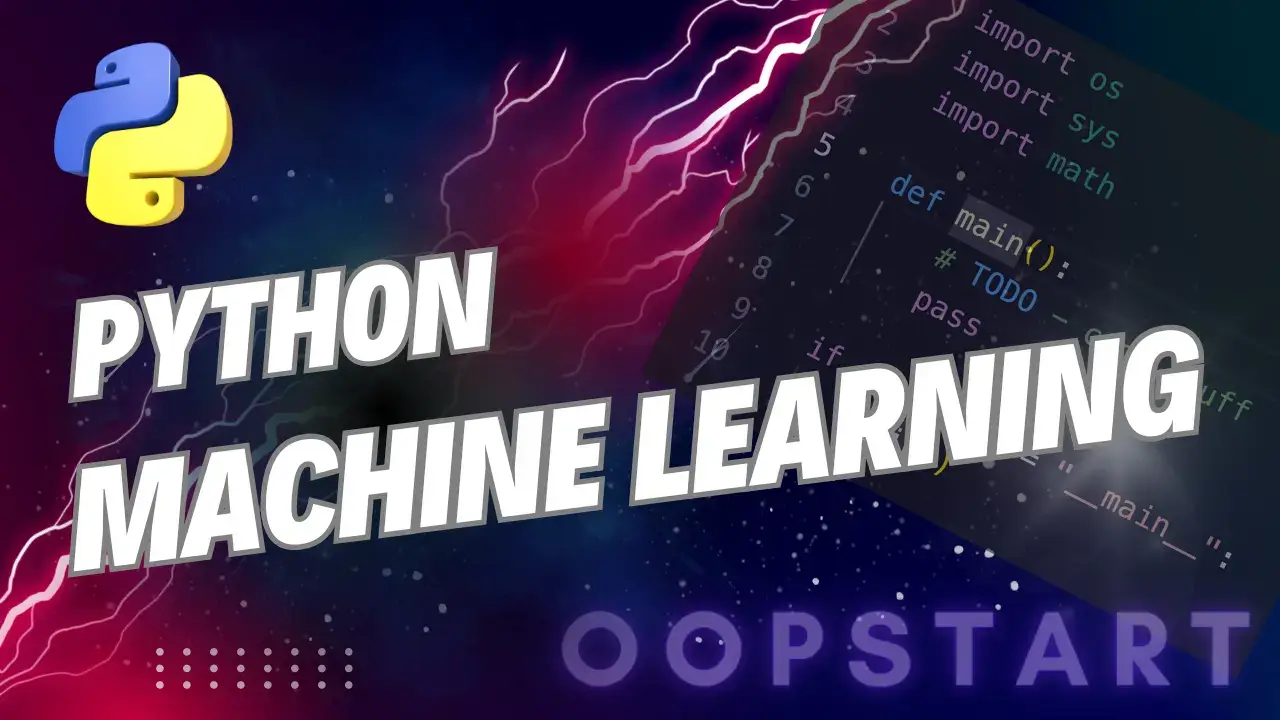Python Machine Learning
In this lesson, we discover machine learning (ML) with Python. By the end, you will understand the key concepts of ML, how to apply different algorithms, and how to build a basic machine learning model using popular libraries such as Scikit-learn.
Table of Contents
What is Machine Learning?
Machine learning is a subset of artificial intelligence (AI) that allows computers to learn from data and improve their performance on a specific task without being explicitly programmed. Machine learning algorithms use patterns in data to make predictions or decisions. There are three main types of machine learning:
- Supervised Learning: The algorithm learns from labeled data, where both the input and output are known. It makes predictions based on the training data. Example tasks include classification (e.g., spam detection) and regression (e.g., predicting house prices).
- Unsupervised Learning: The algorithm works with unlabeled data and tries to uncover hidden patterns or structures. Common tasks include clustering (e.g., grouping customers by behavior) and dimensionality reduction.
- Reinforcement Learning: The algorithm learns by interacting with an environment and receiving feedback in the form of rewards or penalties. It tries to maximize cumulative rewards over time.
Machine Learning Workflow
The machine learning process typically follows these steps:
- Data Collection: Gather and prepare the dataset for training.
- Data Preprocessing: Clean and transform the data into a suitable format for the model.
- Model Selection: Choose the appropriate machine learning algorithm for the task.
- Training the Model: Feed the training data to the model to learn the patterns.
- Model Evaluation: Test the model’s performance on unseen data using metrics like accuracy, precision, and recall.
- Model Tuning: Adjust hyperparameters to improve the model’s performance.
- Prediction: Use the trained model to make predictions on new data.
Python Libraries for Machine Learning
Several Python libraries are essential for building machine learning models:
- Scikit-learn: A simple and efficient library for data mining and machine learning. It provides many algorithms for classification, regression, and clustering.
- Pandas: A powerful library for data manipulation and analysis, particularly for handling tabular data.
- NumPy: Provides support for numerical computations, especially working with arrays and matrices.
- Matplotlib: A plotting library for data visualization.
- Seaborn: A statistical data visualization library built on top of Matplotlib.
You can install these libraries with the following command:
pip install scikit-learn pandas numpy matplotlib seaborn
Building a Machine Learning Model with Scikit-learn
Let’s walk through building a machine learning model using the Scikit-learn library. We will use a popular dataset, the Iris dataset, to classify different species of iris flowers based on the size of their petals and sepals.


Step 1: Import Libraries and Load Data
We begin by importing the necessary libraries and loading the Iris dataset, which is included in Scikit-learn.
import numpy as np
import pandas as pd
from sklearn.datasets import load_iris
from sklearn.model_selection import train_test_split
from sklearn.preprocessing import StandardScaler
from sklearn.neighbors import KNeighborsClassifier
from sklearn.metrics import accuracy_score
import matplotlib.pyplot as plt
import seaborn as sns
# Load the Iris dataset
iris = load_iris()
df = pd.DataFrame(iris.data, columns=iris.feature_names)
df['species'] = iris.target
print(df.head())
The Iris dataset contains four features (sepal length, sepal width, petal length, and petal width) and three species (Setosa, Versicolor, and Virginica). Each row represents one flower.
Step 2: Data Preprocessing
Before training the model, we need to preprocess the data. This includes splitting the data into training and test sets and scaling the features to ensure that they are on the same scale.
# Split the dataset into features (X) and target (y)
X = iris.data
y = iris.target
# Split the data into training and test sets (80% train, 20% test)
X_train, X_test, y_train, y_test = train_test_split(X, y, test_size=0.2, random_state=42)
# Standardize the features (mean = 0, variance = 1)
scaler = StandardScaler()
X_train = scaler.fit_transform(X_train)
X_test = scaler.transform(X_test)
train_test_split(): Splits the dataset into training and test sets.StandardScaler(): Scales the features so that they have a mean of 0 and a standard deviation of 1, which is important for algorithms that are sensitive to feature scaling.
Step 3: Train the Model
We will use the K-Nearest Neighbors (KNN) algorithm to classify the iris species. KNN is a simple yet effective algorithm that classifies a data point based on the majority class of its nearest neighbors.
# Create and train the KNN classifier
knn = KNeighborsClassifier(n_neighbors=3)
knn.fit(X_train, y_train)
# Make predictions on the test set
y_pred = knn.predict(X_test)
KNeighborsClassifier(): Creates a KNN classifier. Then_neighborsparameter defines the number of neighbors to consider for voting.fit(): Trains the model using the training data.predict(): Makes predictions on the test data.
Step 4: Evaluate the Model
After training the model, we evaluate its performance on the test data by calculating the accuracy.
# Evaluate the model's accuracy
accuracy = accuracy_score(y_test, y_pred)
print(f"Model Accuracy: {accuracy * 100:.2f}%")
accuracy_score(): Computes the accuracy of the model, which is the percentage of correct predictions.
Common Machine Learning Algorithms
Here are some popular machine learning algorithms used for various tasks:
1. Linear Regression (for regression tasks)
Predicts a continuous target variable based on input features.
from sklearn.linear_model import LinearRegression
# Create and train a linear regression model
reg = LinearRegression()
reg.fit(X_train, y_train)
# Make predictions
y_pred = reg.predict(X_test)
2. Logistic Regression (for binary classification)
A linear model used for binary classification tasks.
from sklearn.linear_model import LogisticRegression
# Create and train a logistic regression model
logreg = LogisticRegression()
logreg.fit(X_train, y_train)
# Make predictions
y_pred = logreg.predict(X_test)
3. Decision Tree (for classification and regression)
A tree-based model that splits the data into subsets based on feature values.
from sklearn.tree import DecisionTreeClassifier
# Create and train a decision tree classifier
tree = DecisionTreeClassifier()
tree.fit(X_train, y_train)
# Make predictions
y_pred = tree.predict(X_test)
4. Support Vector Machine (SVM) (for classification and regression)
An algorithm that finds the optimal boundary (hyperplane) to separate classes.
from sklearn.svm import SVC
# Create and train an SVM classifier
svm = SVC()
svm.fit(X_train, y_train)
# Make predictions
y_pred = svm.predict(X_test)
5. Random Forest (for classification and regression)
An ensemble model that combines multiple decision trees for better performance.
from sklearn.ensemble import RandomForestClassifier
# Create and train a random forest classifier
rf = RandomForestClassifier(n_estimators=100)
rf.fit(X_train, y_train)
# Make predictions
y_pred = rf.predict(X_test)
Hyperparameter Tuning
Hyperparameters are parameters that control the behavior of the learning algorithm (e.g., the number of neighbors in KNN or the depth of a decision tree). Tuning these hyperparameters can significantly improve the model’s performance. Scikit-learn provides tools such as GridSearchCV and RandomizedSearchCV to help with hyperparameter tuning.
Example: Tuning Hyperparameters with GridSearchCV
from sklearn.model_selection import GridSearchCV
# Define the hyperparameters to tune
param_grid = {'n_neighbors': [3, 5, 7, 9]}
# Use GridSearchCV to find the best hyperparameters
grid_search = GridSearchCV(KNeighborsClassifier(), param_grid, cv=5)
grid_search.fit(X_train, y_train)
# Print the best hyperparameters
print(f"Best parameters: {grid_search.best_params_}")
GridSearchCV(): Performs an exhaustive search over the specified hyperparameter grid to find the best combination.
Model Evaluation Metrics
To evaluate a machine learning model, you can use various metrics depending on the task:
- Accuracy: The proportion of correctly classified samples (for classification tasks).
- Precision: The proportion of true positives among the predicted positives (useful in cases with imbalanced classes).
- Recall: The proportion of true positives identified out of all actual positives.
- F1 Score: The harmonic mean of precision and recall.
- **Mean Squared Error (MSE)**: The average of the squared differences between predicted and actual values (for regression tasks).
Example of evaluating precision, recall, and F1-score:
from sklearn.metrics import classification_report
# Generate a classification report
print(classification_report(y_test, y_pred))
Key Concepts Recap
In this lesson, we looked at the fundamentals of machine learning, including the types of learning algorithms and the general workflow for building models. Using Python’s Scikit-learn library, we covered how to load data, preprocess it, train different types of models, evaluate performance, and fine-tune hyperparameters.
By mastering these foundational concepts, you are equipped to apply machine learning to various tasks, such as classification, regression, and clustering. This knowledge will enable you to build more sophisticated models, explore more advanced algorithms, and improve your machine learning skills.
Exercises
- Train a decision tree model on the Iris dataset and evaluate its performance. Experiment with different maximum depths for the tree to see how it affects accuracy.
- Use the Boston Housing dataset to build a linear regression model that predicts house prices. Evaluate the model using the Mean Squared Error (MSE).
- Implement a K-Nearest Neighbors classifier on a dataset of your choice. Use GridSearchCV to find the optimal value for the number of neighbors.
- Build a random forest classifier on the MNIST dataset (handwritten digits) and evaluate its performance using accuracy, precision, and recall.
FAQ
Q1: What is the difference between supervised, unsupervised, and reinforcement learning?
A1:
- Supervised Learning: The algorithm is trained on labeled data, meaning both the input and output (target) are known. The goal is to predict the output based on new input data. Common tasks include classification (e.g., email spam detection) and regression (e.g., predicting house prices).
- Unsupervised Learning: The algorithm works with unlabeled data, and the goal is to identify patterns, groupings, or structures in the data without predefined labels. Examples include clustering (e.g., customer segmentation) and dimensionality reduction.
- Reinforcement Learning: The algorithm learns by interacting with an environment and receiving feedback through rewards or penalties. It continuously improves its strategy by maximizing cumulative rewards, often used in game-playing algorithms or robotics.
Q2: What is Scikit-learn, and why is it important for machine learning in Python?
A2: Scikit-learn is one of the most widely used Python libraries for machine learning. It provides a simple and efficient set of tools for data mining, data analysis, and machine learning. Scikit-learn is built on other libraries such as NumPy and provides many easy-to-use functions for model building, training, evaluation, and tuning. It includes a wide variety of algorithms, from classification and regression to clustering and dimensionality reduction.
Q3: How do I choose the right machine learning algorithm for my task?
A3: The choice of algorithm depends on the type of task and the characteristics of the dataset:
- For classification: Consider algorithms like K-Nearest Neighbors (KNN), Logistic Regression, Decision Trees, Support Vector Machines (SVM), or Random Forest.
- For regression: Use models like Linear Regression, Ridge/Lasso Regression, or Decision Trees (for nonlinear relationships).
- For clustering: Consider K-Means, Hierarchical Clustering, or DBSCAN if the task is to group data without labels.
- For dimensionality reduction: Use Principal Component Analysis (PCA) if you need to reduce the number of features while retaining the structure of the data.
The choice also depends on factors such as data size, dimensionality, and whether the task is linear or nonlinear.
Q4: What is the purpose of splitting the data into training and test sets?
A4: Splitting the data into training and test sets is crucial to evaluate the performance of the machine learning model on unseen data. The training set is used to teach the model, while the test set is reserved to assess how well the model generalizes to new, unseen examples.
By testing the model on data it hasn’t seen before, you can better understand how it will perform in real-world scenarios. A common split is 80% training and 20% testing, though this can vary depending on the size of the dataset.
Q5: What is overfitting, and how can I prevent it?
A5: Overfitting occurs when a machine learning model learns not just the underlying patterns in the training data but also the noise, making it too complex and unable to generalize well to new data. It performs well on the training set but poorly on the test set.
To prevent overfitting:
- Use simpler models that are less prone to capturing noise.
- Regularization techniques like Lasso and Ridge regression can penalize overly complex models.
- Collect more training data if possible.
- Use cross-validation to validate the model’s performance on different subsets of the data.
Q6: What is the difference between accuracy, precision, recall, and F1-score?
A6: These metrics are used to evaluate classification models:
- Accuracy: The proportion of correct predictions out of all predictions. It is useful when the classes are balanced.
- Precision: The proportion of true positives among the predicted positives. Precision is important when minimizing false positives is critical (e.g., in spam detection).
- Recall: The proportion of true positives identified out of all actual positives. Recall is crucial when minimizing false negatives is important (e.g., in medical diagnosis).
- F1-score: The harmonic mean of precision and recall. It provides a balanced measure when you need to consider both precision and recall, especially when dealing with imbalanced classes.
Q7: How do I handle missing data in a dataset?
A7: Handling missing data is important to ensure the model can be trained effectively. Common approaches include:
- Removing rows or columns that contain missing values, especially if the percentage of missing data is small.
- Imputing missing values by filling in the missing data using strategies like the mean, median, or mode.
- Using more advanced imputation techniques like K-Nearest Neighbors imputation or regression imputation.
In Python, you can use Pandas to handle missing values:
df.fillna(df.mean(), inplace=True) # Fill missing values with the mean
Q8: What is the role of hyperparameter tuning in machine learning?
A8: Hyperparameter tuning is the process of optimizing the parameters that control the learning process (e.g., the number of neighbors in KNN or the maximum depth of a decision tree). These hyperparameters are set before the training process and can greatly influence model performance.
Tools like GridSearchCV or RandomizedSearchCV in Scikit-learn help automate hyperparameter tuning by searching for the best parameter combinations.
Q9: Why do we use scaling in machine learning, and how is it done?
A9: Feature scaling ensures that all the input features have the same scale, which is crucial for algorithms that are sensitive to the range of data, such as K-Nearest Neighbors (KNN), Support Vector Machines (SVM), and Gradient Descent-based algorithms.
Two common methods:
- Standardization: Transforms the features so they have a mean of 0 and a standard deviation of 1. Use
StandardScaler()for this. - Normalization: Scales the features to a range of [0, 1]. Use
MinMaxScaler()for this.
Example:
from sklearn.preprocessing import StandardScaler
scaler = StandardScaler()
X_train_scaled = scaler.fit_transform(X_train)
X_test_scaled = scaler.transform(X_test)
Q10: What is cross-validation, and why is it important?
A10: Cross-validation is a technique for assessing the performance of a machine learning model by splitting the data into multiple training and testing sets, which allows the model to be tested on different subsets of the data. This helps provide a more accurate measure of how well the model generalizes to unseen data.
The most common method is k-fold cross-validation, where the data is split into k subsets, and the model is trained and evaluated k times, with each subset serving as the test set once.
Q11: How can I handle imbalanced datasets?
A11: Imbalanced datasets occur when one class is significantly more prevalent than another (e.g., in fraud detection). Common techniques to handle imbalanced datasets include:
- Resampling: Either oversample the minority class or undersample the majority class.
- SMOTE (Synthetic Minority Over-sampling Technique): Generate synthetic examples for the minority class.
- Use algorithms that are more robust to imbalanced data, like Random Forest or XGBoost.
- Adjust the class weights in algorithms such as SVM or Logistic Regression.
Example of setting class weights in Scikit-learn:
from sklearn.linear_model import LogisticRegression
logreg = LogisticRegression(class_weight='balanced')
Q12: How can I evaluate a regression model?
A12: For regression models, some common evaluation metrics include:
- Mean Squared Error (MSE): The average of the squared differences between the predicted and actual values.
- Mean Absolute Error (MAE): The average of the absolute differences between the predicted and actual values.
- R-squared (R²): A measure of how well the model explains the variance in the target variable.
Example of evaluating MSE in Scikit-learn:
from sklearn.metrics import mean_squared_error
mse = mean_squared_error(y_test, y_pred)
print(f"Mean Squared Error: {mse}")
Q13: What is the difference between a parameter and a hyperparameter?
A13:
- Parameter: A value that the model learns from the training data during the training process, such as the weights in a linear regression model.
- Hyperparameter: A value set before the training process that controls the learning algorithm, such as the number of neighbors in KNN or the maximum depth of a decision tree. Hyperparameters need to be tuned to find the best settings for the model.







